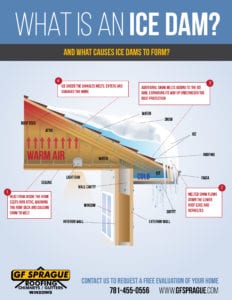Roof & Ice Damage
Ice Dam Prevention & Damage Repair in Newton, Needham, Wellesley
Providing solutions to protect your roof from ice dams & water damage
 One thing that homeowners dread during snowy weather is the formation of ice dams along the edge of the roof.
An ice dam earns its name by trapping pools of melted water behind the frozen dam created when melted snow re-freezes along the eaves, where the roof is coldest.
Water trapped behind an ice dam can flow under roof shingles and leak into the house, damaging walls, floors, and other materials.
Several conditions must exist for ice dam damage to occur. If all these conditions are present, it's likely that some water will leak into your house.
Here at GF Sprague, we offer solutions to repair damage to your roof caused by ice damming, as well as prevent ice dams from forming on your roof.
One thing that homeowners dread during snowy weather is the formation of ice dams along the edge of the roof.
An ice dam earns its name by trapping pools of melted water behind the frozen dam created when melted snow re-freezes along the eaves, where the roof is coldest.
Water trapped behind an ice dam can flow under roof shingles and leak into the house, damaging walls, floors, and other materials.
Several conditions must exist for ice dam damage to occur. If all these conditions are present, it's likely that some water will leak into your house.
Here at GF Sprague, we offer solutions to repair damage to your roof caused by ice damming, as well as prevent ice dams from forming on your roof.
Prevention is key in keeping ice off your roof and water out of your home
While you can't prevent snow from collecting on your roof, there are other things you can do to prevent ice dams from causing water damage to your house. Some homeowners choose to focus on reducing the amount of heat that escapes into the attic, warming the upper part of the roof deck and causing snow to melt evenly. This type of ice dam prevention typically involves sealing air leaks in the attic floor and other solutions. Adequate attic ventilation is also important to keep the underside of the roof the same temperature as the outside air. [video width="1920" height="1080" mp4="https://gfsprague.com/wp-content/uploads/2021/01/HOW-ICE-DAMS-FORM.mp4"][/video] Another way to protect your home from ice dams and the damage associated with them is to make sure that an experienced roofing contractor installs a protective "ice and water" shield along your roof eaves, where the ice dams form. Many building codes (this may vary by state and town) stipulate that this ice dam membrane protection must extend at least 24 inches inside the heated wall space of a house. However, older houses may not have such protection.How do ice dams form?
- Snow that stays on the roof for more than a few days, combined with freezing temperatures.
- Warm air from your living space that leaks into the attic, causing snow to melt high on the roof.
- Missing membrane protection beneath roof shingles along roof eaves.
See Roofing, Emergency Repairs before & after galleries:
Asphalt Shingle Roof Replacement in Chestnut Hill, MA
read more
Complete Shingle Roof Replacement in Beverly, MA
read more
Copper Barrel Roof in Weston, MA
read more
Copper Flashing in Lexington, MA
read more
Copper Flashing Replacement Good for the Next 50 Years
read more
Copper Gutter Liner on Slate Roof in Waban, MA
read more
